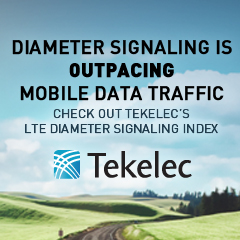Is VoLTE Ready for Prime-time?
VoLTE and the customer
Much has been made about the enhancements to customer experience that will come from making VoLTE more widely available. But customers will first have to get comfortable with the new billing models that are to follow.
‚ÄúOperators have a job to do educating customers [about] aspects of the overall charging model,‚ÄĚ says Mavenir‚Äôs Ian Maclean. For example, a VoLTE call ‚Äútypically consumes credit from the customer‚Äôs data package, not the minutes bundle. But overall the advent of VoLTE liberates operators to deliver more competitive offerings and enhance the services to consumers.‚ÄĚ
It will be interesting to watch how major wireless players like AT&T and Verizon go about educating their customers. The former ‚Äúplans significant enhancements to its LTE network beginning in 2013 and continuing through 2015,‚ÄĚ says Kris Rinne, senior vice president of architecture and planning. ‚ÄúAT&T‚Äôs infrastructure was designed from the beginning to incorporate many of these LTE Advanced enhancements as they become available‚ÄĚ and ‚Äúplans to roll out VoLTE and HD Voice in some markets before the end of 2013.‚ÄĚ
Meanwhile, Verizon says VoLTE will be available to its customers by 2014, but when asked about future plans and uptake predictions, spokeswoman Debra Lewis commented that the CSP is ‚Äúnot in the business of making predictions.‚ÄĚ
VoLTE-to-legacy handovers
Because VoLTE is delivered via a CSP’s data network, it has significant benefits for customers who travel and are concerned about roaming. Recently, Telefónica became the first CSP to demonstrate a breakthrough technology that transfers calls, smoothly and without interruption, from an LTE network to a 3G mobile network. This handover was achieved in Germany in a test-laboratory environment that accurately simulated that of a real mobile network. The voice call is broken into data bits and transmitted in the same way an email or MP3 would move across the internet.
‚ÄúTelef√≥nica has achieved a significant landmark with the successful testing of this mobile broadband network for the future,‚ÄĚ says CTO Enrique Blanco, stressing the company‚Äôs ‚Äúability to deliver the very best customer experience, which is at the core [of] our long-term network strategy. With VoLTE our customers will be seamlessly connected to a superfast, intelligent network that not only gives a top-quality voice service but also ... opens up a new world of opportunities, such as high-definition video calls.‚ÄĚWhile there has been some progress with VoLTE in the United States and South Korea, today‚Äôs LTE networks are not able to hand over a VoLTE voice call to 2G or 3G when moving out of LTE coverage. This means most networks fall back to a legacy 2G/3G network whenever they make or receive a voice call. Telef√≥nica‚Äôs engineers in Germany have demonstrated that the SRVCC standard (single radio voice call continuity) allows for the handover of a VoLTE call from the LTE network to 3G.
VoLTE, and the ability to integrate voice and data traffic, will undoubtedly prove to be a win for CSPs as well as customers. There are plenty of reasons to have unbridled enthusiasm about its promise, but from device quality to new billing models and technological advancements, there’s also plenty of work that needs to be done before VoLTE is ready for prime time. However, it will be fascinating to watch as the technology matures across markets in the US and South Korea and comes to life in others. One thing is certain: VoLTE really will be huge.
One day, that is. Just not today. Or maybe even tomorrow. Stay tuned ...





















